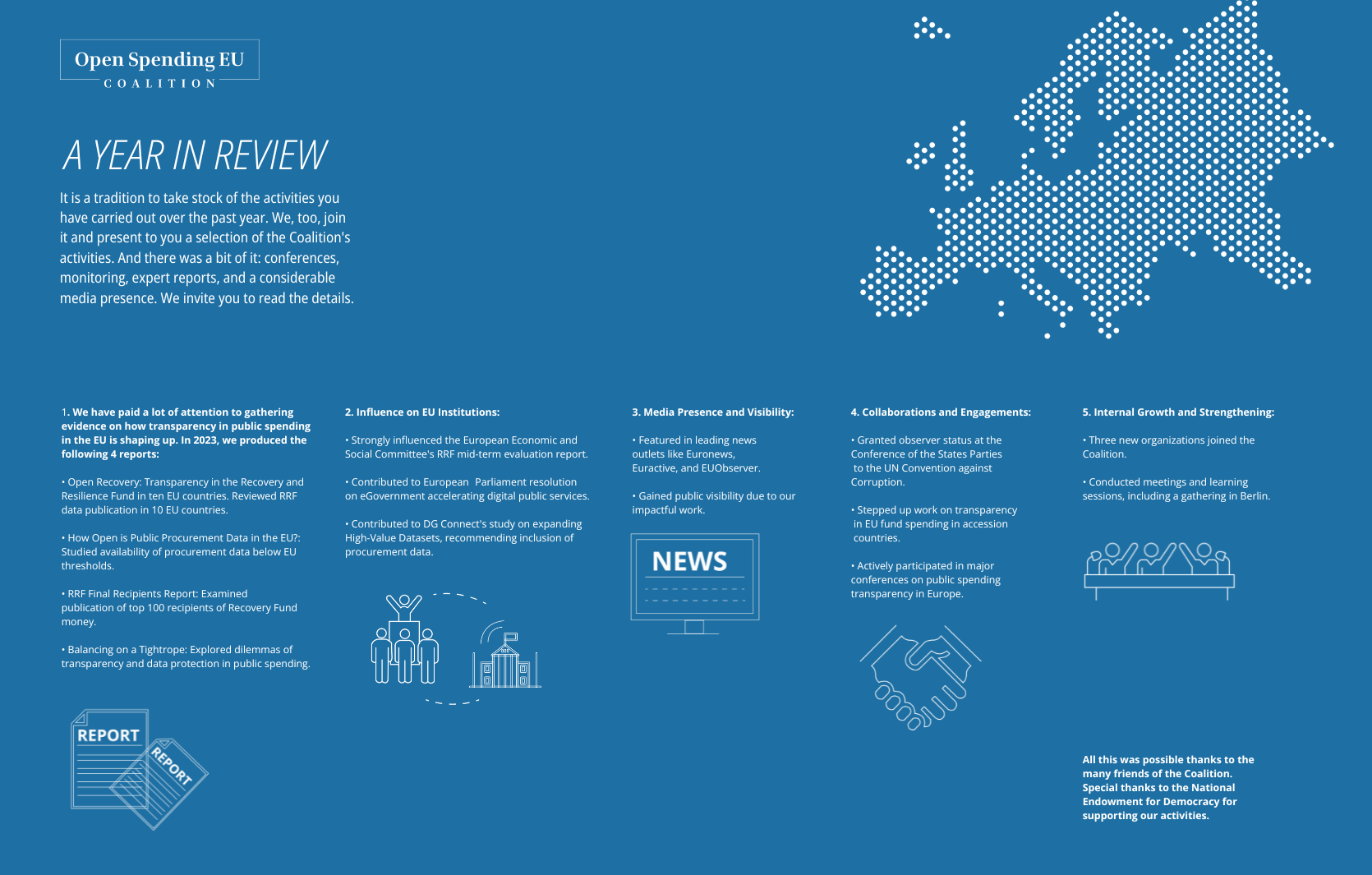
Published date
21 Feb, 2024
The European Commission published its Recovery and Resilience Facility Mid-term Evaluation Report on 21 February. Much emphasis was also placed on the transparency of expenditure from this fund.
Let us recall that from the very beginning of the introduction of this financial instrument, our Coalition has supported actions around greater transparency in spending. You can see what we have been doing and what we have achieved on the campaign page we are running in this area.
The report published today is very comprehensive and addresses many aspects of the RRF. Below we will focus only briefly on the parts that are dedicated to spending transparency:
Information on the state of implementation of the RRF and on final recipients is continuously being made available. The Commission has set up a website dedicated to the RRF – which includes the individual RRPs in dedicated country pages – as well as the Recovery and Resilience Scoreboard that provides real-time information on the disbursements and progress made by Member States, as well as additional data, indicators and thematic analyses. To further increase the visibility and transparency of the RRF, the Commission has launched an interactive map60 of projects supported by the RRF in each Member State. Furthermore, following the entry into force of the amended RRF Regulation, the Commission has been publishing the data provided by the Member States on the 100 final recipients receiving the highest amount of funding on the Scoreboard. By 1 February 2024, all Member States have provided corresponding data.
To ensure the effective implementation of their plans, some Member States put in place measures to strengthen their administrative capacity, such as reforms and investments aimed at modernising the public administration, including improving the transparency and effectiveness of tendering procedures and their compliance with EU legislation.
Several stakeholders, in particular the national coordination bodies, have called for a better balance between transparency/control and the resulting administrative costs. From the point of view of the Member States, the RRF has not brought the expected simplification of administrative procedures compared to other EU funding instruments, notably because of the comprehensive audit and control requirements (a perceived overlap between national, Commission and ECA audits has created uncertainty in Member States and an overload of administrative procedures). While the RRF Regulation lays down the audit and control responsibilities of the Member States and obliges the Commission to assess and scrutinise them, the Member States’ understanding of the resulting requirements was sometimes different than the ones imposed by the European Court of Auditors and the European Parliament as discharge authority. Moreover, various reporting obligations for Member States stemming from the Regulation (bi-annual reporting, common indicators, final recipients etc.) involves a significant amount of work for both national administrations and Commission services. These reporting requirements add onto the continuous monitoring of progress on milestones and targets ahead of upcoming payment requests to meet the goals of the Facility. At the same time, they provide transparency and enable communication on the progress with milestones and targets.
It is important to ensure an adequate balance between the necessary level of detail to ensure adequate monitoring and avoidance of ambiguity, while allowing for possibly necessary adjustments during the implementation, taking into account evolving circumstances Moreover, future instruments should be based on objectives fulfilling the S.M.A.R.T criteria, consider a stronger involvement of regional and local authorities as well as non-governmental stakeholders and pay specific attention to reinforcing administrative capacity as well as transparency and communication requirements.
In other news
There are some new developments in the work on the anti-corruption directive. In February, the European Parliament’...
Learn moreWelcome to our review of our members’ activities. What did they since the beginning of 2024? You will find the ans...
Learn moreIt is a tradition to take stock of the activities you have carried out over the past year. We, too, join it and present ...
Learn more

